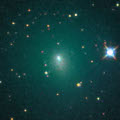
|
Brightening rapidly. Now it is 10.4 mag (Sept. 2, Gabor Santa). This apparition is best condition. It will approach to the earth down to 0.12 A.U. in October, and brighten up to 5 mag. It will be visible with naked eyes. In the Northern Hemisphere, it keeps observable all through this apparition until 2011 June when it fades down to 17 mag. In the Southern Hemisphere, it becomes unobservable temporarily from late September to mid October. But then it keeps observable in good condition.
Date(TT) R.A. (2000) Decl. Delta r Elong. m1 Best Time(A, h)
Sept. 4 22 54.19 39 26.6 0.369 1.290 133 9.8 0:03 (180, 86)
Sept.11 23 5.43 43 13.2 0.315 1.240 131 9.1 23:45 (180, 81)
|
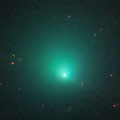
|
Now it is so bright as 8.7 mag (Aug. 21, Alexandre Amorim). It keeps observable bright as 9-10 mag for a long time until autumn. A thin straight dust trail is visible.
Date(TT) R.A. (2000) Decl. Delta r Elong. m1 Best Time(A, h)
Sept. 4 1 39.39 -16 6.5 0.656 1.558 137 9.8 2:48 ( 0, 39)
Sept.11 1 39.45 -17 29.0 0.666 1.588 142 9.9 2:21 ( 0, 38)
|
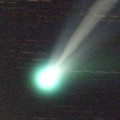
|
Appearing in the morning sky in the Southern Hemisphere. It approached to the sun down to 0.4 A.U. in July, and was expected to reach up to 2-3 mag. But actually, it brightened only up to 5 mag at best. It will keep observable while fading after this in the Southern Hemisphere. In the Northern Hemisphere, it will never be observable again.
Date(TT) R.A. (2000) Decl. Delta r Elong. m1 Best Time(A, h)
Sept. 4 10 0.39 -29 6.1 2.098 1.450 38 10.0 4:07 (287,-28)
Sept.11 10 11.95 -33 30.8 2.180 1.569 41 10.5 4:13 (294,-26)
|

|
Observable in the evening sky in the Southern Hemisphere. Fading rapidly. It was bright as 7.7 mag on Aug. 17 (Chris Wyatt), but it is 9.8 mag now (Sept. 1, Marco Goiato). It will keep observable while fading rapidly after this in the Southern Hemisphere. It is not observable in the Northern Hemisphere.
Date(TT) R.A. (2000) Decl. Delta r Elong. m1 Best Time(A, h)
Sept. 4 13 9.96 -15 32.8 1.123 0.761 41 10.7 19:50 ( 73, -3)
Sept.11 13 58.77 -20 33.0 1.169 0.885 47 11.8 19:39 ( 64, 0)
|
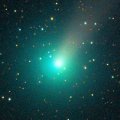
|
It brightened up to 7.9 mag in April and May (May 5, Juan Jose Gonzalez). Now it is fading. But it is still bright as 10.8 mag (Aug. 20, Juan Jose Gonzalez). It keeps observable for a long time until when it fades out in the Northern Hemisphere. It will be visible visually until autumn. It is not observable in the Southern Hemisphere.
Date(TT) R.A. (2000) Decl. Delta r Elong. m1 Best Time(A, h)
Sept. 4 8 14.94 51 43.2 2.678 2.250 54 11.7 4:07 (227, 33)
Sept.11 8 14.91 51 19.1 2.656 2.319 59 11.9 4:13 (229, 38)
|
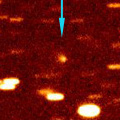
|
It brightened up to 15.5 mag in January (Jan. 31, C. Rinner, F. Kugel). It is not observable now. The condition of this apparition is bad. It has not been observable at all around the maximum brightness. It will appear in the morning sky in October.
Date(TT) R.A. (2000) Decl. Delta r Elong. m1 Best Time(A, h)
Sept. 4 9 21.02 6 33.6 2.421 1.536 22 12.6 4:07 (261, -1)
Sept.11 9 39.42 4 27.9 2.437 1.572 24 12.8 4:13 (265, 1)
|
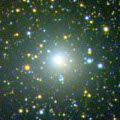
|
It reached up to 7.7 mag in last summer (2009 Aug. 13, Chris Wyatt). It is fading now. It has already faded down to 12.6 mag (Aug. 7, Marco Goiato). In the Southern Hemisphere, it keeps observable for a long time after this. In the Northern Hemisphere, it will never be observable again.
Date(TT) R.A. (2000) Decl. Delta r Elong. m1 Best Time(A, h)
Sept. 4 17 19.88 -47 33.8 4.735 5.015 100 13.1 19:50 ( 14, 5)
Sept.11 17 16.62 -47 25.6 4.898 5.062 93 13.3 19:39 ( 17, 4)
|
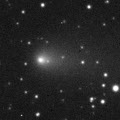
|
Now it is 11.7 mag (Aug. 6, Juan Jose Gonzalez). It will keep 12-13 mag until autumn. It is observable in excellent condition in the Southern Hemisphere. It locates somewhat low in the Northern Hemisphere.
Date(TT) R.A. (2000) Decl. Delta r Elong. m1 Best Time(A, h)
Sept. 4 20 34.52 -33 19.4 1.842 2.687 139 13.3 21:40 ( 0, 22)
Sept.11 20 33.28 -33 3.3 1.918 2.704 132 13.4 21:12 ( 0, 22)
|

|
Already bright as 12.8 mag and visible visually (Aug. 20, Juan Jose Gonzalez). It is expected to keep so bright as 6-8 mag for a long time from 2011 to 2012, and to be observable in good condition in the Northern Hemisphere. In 2010, it is observable in good condition in the Southern Hemisphere while brightening slowly. It locates low in the Northern Hemisphere, but it keeps observable until the end of 2010.
Date(TT) R.A. (2000) Decl. Delta r Elong. m1 Best Time(A, h)
Sept. 4 23 6.27 -38 0.9 4.678 5.568 149 14.3 0:16 ( 0, 17)
Sept.11 22 57.75 -38 12.4 4.641 5.507 146 14.2 23:35 ( 0, 17)
|

|
Now it is unobservable. It will appear in the morning sky again in October.
Date(TT) R.A. (2000) Decl. Delta r Elong. m1 Best Time(A, h)
Sept. 4 10 25.02 6 37.1 7.230 6.229 6 14.3 4:07 (252,-14)
Sept.11 10 29.82 6 4.8 7.213 6.230 11 14.2 4:13 (257, -8)
|
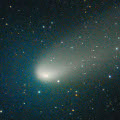
|
It reached up to 9.2 mag in March (Mar. 20, Marco Goiato). Now it is fading. It has already faded down to 14.8 mag (Sept. 1, Hidetaka Sato). It will be getting lower in the evening sky, and will be unobservable in November.
Date(TT) R.A. (2000) Decl. Delta r Elong. m1 Best Time(A, h)
Sept. 4 15 54.38 -17 41.8 2.363 2.386 78 14.8 19:50 ( 44, 24)
Sept.11 16 5.67 -18 23.6 2.485 2.427 74 15.0 19:39 ( 45, 23)
|
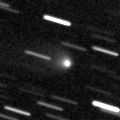
|
Now it is 15.3 mag (Sept. 1, Toshiyuki Takahashi). It will be observable at 13-14 mag for a long time from 2011 to 2012. In 2010, it is observable at 15-16 mag in good condition from spring to autumn.
Date(TT) R.A. (2000) Decl. Delta r Elong. m1 Best Time(A, h)
Sept. 4 20 43.03 -1 40.3 5.868 6.742 147 15.1 21:48 ( 0, 53)
Sept.11 20 37.21 -2 14.1 5.905 6.710 140 15.1 21:15 ( 0, 53)
|
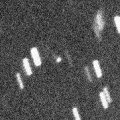
|
Now it is 14.8 mag, much brighter than originally expected (Aug. 21, Hidetaka Sato). It keeps observable in good condition from autumn to next spring. It will brighten up to 13 mag and will be visible visually.
Date(TT) R.A. (2000) Decl. Delta r Elong. m1 Best Time(A, h)
Sept. 4 7 41.22 28 17.8 3.893 3.324 49 15.3 4:07 (255, 31)
Sept.11 7 44.27 27 1.2 3.764 3.293 55 15.1 4:13 (260, 36)
|
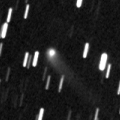
|
Now it is very bright as 14.2 mag (July 8, Toni Scarmato). It keeps observable at 14-15 mag for a long time in 2010. It locates in good condition in the Northern Hemisphere. It locates low, and will be unobservable in October in the Southern Hemisphere.
Date(TT) R.A. (2000) Decl. Delta r Elong. m1 Best Time(A, h)
Sept. 4 17 29.01 39 5.1 4.354 4.516 92 15.2 19:50 (111, 75)
Sept.11 17 32.06 38 22.1 4.396 4.513 90 15.3 19:39 (107, 72)
|
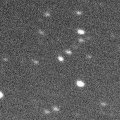
|
Now it is 14.8 mag (June 23, Hidetaka Sato). It keeps bright as 14-15 mag for a long time after this until 2013. It is observable in good condition in the Southern Hemisphere. However, it is not observable in the Northern Hemisphere.
Date(TT) R.A. (2000) Decl. Delta r Elong. m1 Best Time(A, h)
Sept. 4 14 24.87 -47 49.2 6.719 6.487 72 15.3 19:50 ( 38,-11)
Sept.11 14 27.34 -48 1.0 6.782 6.461 67 15.3 19:39 ( 39,-13)
|
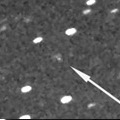
|
The condition in this apparition is bad. It keeps unobservable for a while. In the Southern Hemisphere, it will appear in the morning sky at 12.5 mag in February, then it keeps observable while fading gradually. In the Northern Hemisphere, it is not observable until when it fades down to 15 mag.
Date(TT) R.A. (2000) Decl. Delta r Elong. m1 Best Time(A, h)
Sept. 4 11 40.50 9 22.0 2.931 1.958 12 15.6 19:50 (107, -7)
Sept.11 11 55.40 7 33.8 2.902 1.920 10 15.4 19:39 (105, -9)
|
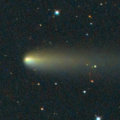
|
It brightened up to 9.5 mag in January (Jan. 13, Juan Jose Gonzalez). Now it is fading. It has already faded down to 15.8 mag (Sept. 1, Toshiyuki Takahashi). It will be fainter than 18 mag at the end of 2010. In the Northern Hemisphere, it keeps observable for a long time, although it will be getting lower gradually. It is not observable in the Southern Hemisphere.
Date(TT) R.A. (2000) Decl. Delta r Elong. m1 Best Time(A, h)
Sept. 4 15 27.31 43 54.1 4.428 4.191 69 15.7 19:50 (118, 52)
Sept.11 15 35.17 42 34.2 4.513 4.247 68 15.8 19:39 (117, 50)
|
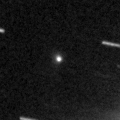
|
Now it is 15.1 mag, brighter than expected (Aug. 25, Ken-ichi Kadota). In the Northern Hemisphere, it will be observable at 15 mag in good condition from autumn to winter. In the Southern Hemisphere, it will be unobservable until 2011 spring.
Date(TT) R.A. (2000) Decl. Delta r Elong. m1 Best Time(A, h)
Sept. 4 11 44.90 70 57.3 3.263 2.966 64 16.3 19:50 (159, 28)
Sept.11 12 14.23 71 27.0 3.165 2.928 67 16.2 19:39 (159, 30)
|

|
It keeps 16 mag until the end of 2010. It keeps observable in good condition in the Southern Hemisphere. But it is not observable at all in the Northern Hemisphere. It must have been bright, but no observations have been reported since May.
Date(TT) R.A. (2000) Decl. Delta r Elong. m1 Best Time(A, h)
Sept. 4 8 26.19 -45 10.6 3.093 2.761 61 16.4 4:07 (312,-19)
Sept.11 8 28.27 -47 52.4 3.039 2.753 64 16.3 4:13 (318,-16)
|
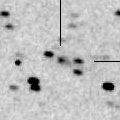
|
Recovered as bright as expected. Now it is 16.5 mag (Aug. 11, Hidetaka Sato). It is observable at 15.5 mag in good condition from autumn to winter. It locates somewhat low in the Southern Hemisphere.
Date(TT) R.A. (2000) Decl. Delta r Elong. m1 Best Time(A, h)
Sept. 4 5 37.25 15 35.1 2.127 2.137 76 16.6 4:07 (288, 50)
Sept.11 5 48.90 16 26.6 2.048 2.132 80 16.5 4:13 (293, 54)
|
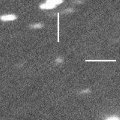
|
Now it is 17.6 mag (Aug. 6, Yasukazu Ikari). It keeps 17 mag for a long time from 2009 to 2012. It is observable in good condition in the Northern Hemisphere. It locates somewhat low in the Southern Hemisphere.
Date(TT) R.A. (2000) Decl. Delta r Elong. m1 Best Time(A, h)
Sept. 4 2 15.14 21 14.5 7.608 8.192 122 17.0 3:24 ( 0, 76)
Sept.11 2 10.90 21 7.5 7.500 8.183 129 17.0 2:53 ( 0, 76)
|
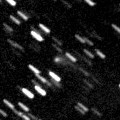
|
Now it is 17.1 mag (July 18, Ken-ichi Kadota). In the Northern Hemisphere, it keeps observable while fading gradually, and it will be fainter than 18 mag in November. In the Southern Hemisphere, it will never be observable again in this apparition.
Date(TT) R.A. (2000) Decl. Delta r Elong. m1 Best Time(A, h)
Sept. 4 7 1.75 63 59.1 2.797 2.620 69 17.0 4:07 (212, 44)
Sept.11 7 23.72 64 59.7 2.789 2.669 72 17.1 4:13 (210, 45)
|
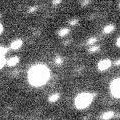
|
Now it is 18.0 mag (Aug. 20, Jean-Francois Soulier). It was observed at 17 mag in summer and autumn in 2009. It is observable again at 17 mag in summer and autumn also in 2010. But actually, it is fainter than expected now. It locates in good condition in the Northern Hemisphere, but somewhat low in the Southern Hemisphere.
Date(TT) R.A. (2000) Decl. Delta r Elong. m1 Best Time(A, h)
Sept. 4 3 20.89 23 8.7 2.159 2.641 107 17.1 4:07 (336, 77)
Sept.11 3 23.88 23 4.1 2.094 2.660 113 17.1 4:05 ( 0, 78)
|
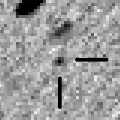
|
Now it is 19.1 mag (Aug. 25, M. Jaeger, E. Prosperi, W. Vollmann). It will be observable at 17 mag in good condition from autum to winter in the Northern Hemisphere. But actually, it is much fainter than expected. It is not observable in the Southern Hemisphere.
Date(TT) R.A. (2000) Decl. Delta r Elong. m1 Best Time(A, h)
Sept. 4 2 48.14 40 54.9 1.924 2.424 107 17.3 3:57 (180, 84)
Sept.11 2 50.42 43 1.4 1.863 2.428 112 17.2 3:32 (180, 82)
|

|
Now it is 16.9 mag (Aug. 11, Ken-ichi Kadota). Now it is brightest. It will be fainter than 18 mag in November. It locates in excellent condition in the Southern Hemisphere, but it locates low in the Northern Hemisphere.
Date(TT) R.A. (2000) Decl. Delta r Elong. m1 Best Time(A, h)
Sept. 4 20 33.34 -34 0.4 2.409 3.235 138 17.2 21:39 ( 0, 21)
Sept.11 20 31.41 -33 54.0 2.478 3.239 131 17.3 21:10 ( 0, 21)
|
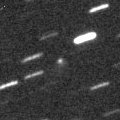
|
Now it is 17.2 mag (Aug. 29, F. Garcia). The condition keeps good, but it will be fainter than 18 mag in November.
Date(TT) R.A. (2000) Decl. Delta r Elong. m1 Best Time(A, h)
Sept. 4 18 41.06 0 59.3 2.916 3.494 117 17.3 19:50 ( 1, 56)
Sept.11 18 32.83 1 11.0 3.051 3.511 109 17.4 19:39 ( 12, 56)
|
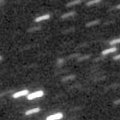
|
Now it is 17.0 mag (Sept. 1, F. Garcia). It keeps 17-18 mag for a long time until 2011 summer. It will be getting lower after this and will be unobservable in late autumn. But it will be observable again in 2011. The condition in 2011 will be good in the Northern Hemisphere, but it locates low in the Southern Hemisphere.
Date(TT) R.A. (2000) Decl. Delta r Elong. m1 Best Time(A, h)
Sept. 4 18 16.63 12 6.8 3.587 4.033 109 17.4 19:50 ( 17, 66)
Sept.11 18 9.59 11 44.3 3.686 4.020 102 17.4 19:39 ( 30, 64)
|
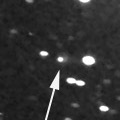
|
It reached up to 16.2 mag in early summer (June 7, P. C. Sherrod). Now it is fading. It keeps observabe in good condition until October when it becomes fainter than 18 mag in the Southern Hemisphere. But it locates somewhat low in the Northern Hemisphere.
Date(TT) R.A. (2000) Decl. Delta r Elong. m1 Best Time(A, h)
Sept. 4 16 12.31 -16 39.7 2.367 2.457 83 17.6 19:50 ( 41, 27)
Sept.11 16 22.90 -17 46.2 2.447 2.461 78 17.7 19:39 ( 42, 25)
|

|
Now it is 17.9 mag (Aug. 20, C. Rinner, F. Kugel). It is observable at 17.5 mag in good condition from summer to autumn in the Northern Hemisphere. It locates somewhat low in the Southern Hemisphere.
Date(TT) R.A. (2000) Decl. Delta r Elong. m1 Best Time(A, h)
Sept. 4 0 59.86 35 11.2 1.032 1.832 127 17.7 2:09 (180, 90)
Sept.11 1 2.27 35 35.4 0.993 1.831 132 17.6 1:44 (180, 89)
|

|
It has not been observed in this apparition yet, but it must have been already bright as 17-18 mag. Now it locates in very good condition in the Southern Hemisphere. But it will be getting lower after this, and will be unobservable in January. In the Northern Hemisphere, it will be observable in good condition while fading gradually from 16 mag after 2011 summer.
Date(TT) R.A. (2000) Decl. Delta r Elong. m1 Best Time(A, h)
Sept. 4 20 15.87 -36 6.8 2.076 2.875 134 17.7 21:22 ( 0, 19)
Sept.11 20 12.19 -36 11.6 2.107 2.835 127 17.6 20:51 ( 0, 19)
|
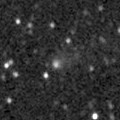
|
It reached up to 14.1 mag and became visible visually in May (May 6, Chris Wyatt). But now it is fading. It has already faded down to 17.5 mag (Aug. 3, Ken-ichi Kadota). It will be fainter than 18 mag soon. It locates in good condition in the Southern Hemisphere, but somewhat low in the Northern Hemisphere.
Date(TT) R.A. (2000) Decl. Delta r Elong. m1 Best Time(A, h)
Sept. 4 17 30.52 -21 48.8 1.784 2.223 101 17.7 19:50 ( 20, 31)
Sept.11 17 41.43 -21 42.7 1.901 2.267 97 17.9 19:39 ( 21, 30)
|

|
It reached up to 11 mag in 2009 spring. Now it is fading. It has already faded down to 17.0 mag (Aug. 3, Ken-ichi Kadota). It will be fainter than 18 mag soon. It locates in good condition in the Southern Hemisphere, but somewhat low in the Northern Hemisphere.
Date(TT) R.A. (2000) Decl. Delta r Elong. m1 Best Time(A, h)
Sept. 4 19 14.84 -26 50.6 2.654 3.340 125 17.8 20:21 ( 0, 28)
Sept.11 19 15.16 -26 40.3 2.764 3.365 118 18.0 19:54 ( 0, 28)
|
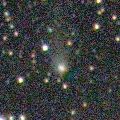
|
It reached up to 11-12 mag from spring to summer in 2008. Now it is fading. It locates already high in the Southern Hemisphere, and it will be getting higher in the Northern Hemisphere, but it will be fainter than 18 mag soon.
Date(TT) R.A. (2000) Decl. Delta r Elong. m1 Best Time(A, h)
Sept. 4 5 53.03 -9 46.0 6.839 6.668 76 17.9 4:07 (309, 29)
Sept.11 5 53.59 -9 57.9 6.792 6.719 81 17.9 4:13 (317, 34)
|
|
![]()
 29P/Schwassmann-Wachmann 1
29P/Schwassmann-Wachmann 1 81P/Wild 2
81P/Wild 2 C/2006 S3 ( LONEOS )
C/2006 S3 ( LONEOS ) C/2010 B1 ( Cardinal )
C/2010 B1 ( Cardinal ) C/2008 FK75 ( Lemmon-Siding Spring )
C/2008 FK75 ( Lemmon-Siding Spring ) C/2009 F4 ( McNaught )
C/2009 F4 ( McNaught ) 9P/Tempel 1
9P/Tempel 1 C/2007 Q3 ( Siding Spring )
C/2007 Q3 ( Siding Spring ) C/2009 Y1 ( Catalina )
C/2009 Y1 ( Catalina ) C/2010 A4 ( Siding Spring )
C/2010 A4 ( Siding Spring ) 240P/2010 P1 ( NEAT )
240P/2010 P1 ( NEAT ) C/2008 S3 ( Boattini )
C/2008 S3 ( Boattini ) 126P/IRAS
126P/IRAS 219P/2009 H1 ( LINEAR )
219P/2009 H1 ( LINEAR ) 223P/2009 L18 ( Skiff )
223P/2009 L18 ( Skiff ) 215P/2009 B5 ( NEAT )
215P/2009 B5 ( NEAT ) C/2010 J2 ( McNaught )
C/2010 J2 ( McNaught ) C/2009 UG89 ( Lemmon )
C/2009 UG89 ( Lemmon ) P/2010 J3 ( McMillan )
P/2010 J3 ( McMillan ) 236P/2010 K1 ( LINEAR )
236P/2010 K1 ( LINEAR ) 164P/Christensen
164P/Christensen P/2010 A5 ( LINEAR )
P/2010 A5 ( LINEAR ) 116P/Wild 4
116P/Wild 4 C/2007 G1 ( LINEAR )
C/2007 G1 ( LINEAR )![]()




























